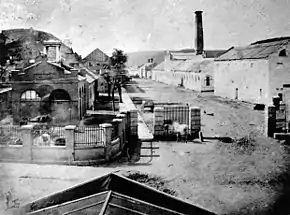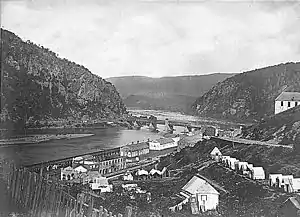Harpers Ferry Armory
Harpers Ferry Armory, more formally known as the United States Armory and Arsenal at Harpers Ferry, was the second federal armory commissioned by the United States government. It was located in Harpers Ferry, Virginia (now West Virginia), while the first federal armory was the Springfield Armory located in Springfield, Massachusetts. In many books, the town is called "Harper's Ferry" with an apostrophe.[1]

The national armory has been associated with many prominent historical events throughout the history of the United States. Harpers Ferry National Armory was both an armory and an arsenal. Both Harpers Ferry and Springfield armories were instrumental in the development of machining techniques to make interchangeable parts.[2]
History
Harpers Ferry
Robert Harper founded the community of Harpers Ferry in the mid-18th century. Robert Harper was born in 1718 in Oxford Township near Philadelphia, Pennsylvania. Since he was a builder, Harper was asked by a group of Quakers in 1747 to build a meeting house in the Shenandoah Valley near the present site of Winchester, Virginia.[3] Traveling through Maryland on his way to the Shenandoah Valley, Harper proceeded to the area where the Potomac and Shenandoah rivers met. Attracted and amazed by the ample latent waterpower that resided in the rivers and by the strategic location for travel and transport, Harper obtained a patent for 125 acres (0.51 km2) of the land in 1751.[4] He built a ferry to cross the Shenandoah River to help pioneers reach their destination in the new western lands. After the creation of the ferry, more people were attracted to the area and it became a destination with flourishing businesses.
The national armory
In 1794, the United States Congress passed a bill calling "for the erecting and repairing of Arsenals and Magazines". President George Washington, given wide latitude in carrying out this order, selected Harpers Ferry, then a part of Virginia, for the location of the Harpers Ferry National Armory.[5] In 1796, the United States government purchased a 125-acre (0.51 km2) parcel of land from the heirs of Robert Harper. Subsequently, in 1799, construction began on the national armory. Three years later, mass production of military arms commenced.[5]
Firearms and cannons are heavy and needed ready access to river and then railroad transportation. The fuel needs of the foundery meant additional heavy shipments. The Armory was located in Harpers Ferry because it was geographically central and during the Antebellum period, at the center of the country's rail network. The only bridge across the Potomac River that could carry a heavy load—for part of this period, the only rail link between eastern cities and Ohio and the "west"—was the Baltimore and Ohio railroad bridge at Harpers Ferry.
The national armory at Harpers Ferry was actually the second national armory. The first was the Springfield Armory, constructed in Springfield, Massachusetts in 1794 after Congress approved the bill to create the nation's first national armory.
Upon its grand opening, the armory's size seemed inadequate for a work force. It consisted of only one room, and the workers numbered a mere twenty-five. Nevertheless, the armory produced many muskets, rifles, and later pistols for the United States. Between 1821–1830 the armory produced 11,855 arms. Each decade after that, production declined.[6] The building relied on river power to drive the armory's machinery.
Expansion and upgrades

In 1844, the deficient state of the armory was taken into account and demand for military equipment increased, and so the renovation and expansion of the armory was undertaken. The upgrades of the arsenal began in 1845–1854 with the construction of seven brand new workshops and the installation of 121 new machines.[5] The new workshops had a brick superstructure with iron framing and slanted sheet metal roofing. These reconstructed arsenal buildings became collectively known as the "U.S. Musket Factory".[5] The armory canal was enlarged so that more water could get to the armory, which meant it would receive more power. Along with the enlargement of the canal, seven new water turbines were installed. The upgrades formed a well-integrated functional unit that improved the flow of work from one stage of production to the next.[7] All the expansions of the armory were done on heavy stone foundations and included cast-iron framing in the general style of "factory Gothic" architecture.[7]
In addition, more people were employed to work at the armory than before: the labor force increased from a minuscule twenty-five in 1802 to about four hundred workers in 1859.[5] Furthermore, the working conditions improved, but only slightly.
John Brown's raid
In 1859, the armory became the site of the famous seizure by abolitionist John Brown, which, while unsuccessful in inciting a slave revolt, helped precipitate the American Civil War and the eventual emancipation of slaves in the United States.
During the Civil War


While Virginia was still in the union, the armory regularly shipped manufactured weapons and material throughout the United States. However, once the Civil War began, the national armory became a vital control point for both the Confederates and the Union.
Close to the beginning of the war on April 18, 1861, just a day after Virginia's conventional ratification of secession, Union soldiers, outnumbered and deprived of reinforcements, set fire to their own armory in an attempt to thwart the usage of it by an advancing Virginian Confederate militia numbering 360 men in all. Harpers Ferry residents (many of whom made their living off the armory) were able to put out the fires swiftly enough to save most of the armory's weapon-making machinery. After rescuing the equipment, the Confederates shipped it south by rail to Winchester, Virginia. The South had virtually no small-arms production and an inadequate supply of raw materials. The machinery taken from Harpers Ferry became the foundation of the Confederate arms manufacturing.[8] Two weeks later, the Confederates abandoned Harpers Ferry. The Southern forces confiscated what was left in the armory and burned the rest of the remaining armory buildings.[5] They also blew up the railroad bridge of the Baltimore and Ohio Railroad, but returned in two weeks to destroy the Rifle Works and a bridge that crossed the Shenandoah river.[7]
The armory's strategic location
During the Civil War, the armory became a site of great strategic importance because it was located very close to the Mason-Dixon line, or the border between the free and the slave-holding states. Consequently, the Union used it as an effective means to supply troops with weapons quickly as they marched into battle. The downside to being on the border was that the armory could easily change hands and fall into Confederate control – the town of Harpers Ferry changed hands at least eleven times during the Civil War.[7]
Aftermath of the Civil War
_archeology_site%252C_at_sunset_(22130382701).jpg.webp)
After the Civil War, John Brown's Fort was the only building to survive the destruction wrought upon it by the Confederates and the Union. The building was named after John Brown for his notorious raid on the Harpers Ferry Armory in 1859. The building was the armory's fire engine and guard house.[5] Due to the degree of damage to the armory during the Civil War, the U.S. government decided not to re-establish the armory at Harpers Ferry, instead focusing the quickly developing areas west of the Mississippi River.[8]
Today the site is mostly covered by railroad track embankments.
See also
References
- For example, Horace Greeley, The American Conflict: A History of the Great Rebellion in the United States of America, 1860–64. Volume: 1. (1866), p. 279; French Ensor Chadwick, Causes of the Civil War, 1859–1861 (1906) p. 74; James M. McPherson, Battle Cry of Freedom: The Civil War Era (1988), p. 201; Stephen W. Sears, Landscape Turned Red: The Battle of Antietam (2003) p. 116.
- Hounshell, David A. (1984), From the American System to Mass Production, 1800–1932: The Development of Manufacturing Technology in the United States, Baltimore, Maryland: Johns Hopkins University Press, ISBN 978-0-8018-2975-8, LCCN 83016269, OCLC 1104810110
- Photo of the Week: Natural Beauty and National History Converge in Harpers Ferry. (October 13, 2016). States News Service. Retrieved from http://0-go.galegroup.com.iii.slcl.org/ps/i.do?p=AONE&sw=w&u=slclpowersearch&v=2.1&it=r&id=GALE%7CA466677270&asid=b6dc2f26a92467112169f2ee1e19c793
- "Robert Harper". National Park Service. Retrieved March 12, 2017.
- Wassel, Marsha (June 2, 2005). "Harpers Ferry NHP Armory and Arsenal". Harpers Ferry National Historical Park. Retrieved November 12, 2008.
- Bellesiles, Michael A. "The Origins of Gun Culture in the United States, 1760–1865". The Journal of American History, vol. 83, no. 2, 1996, pp. 425–455. has, JSTOR 2944942.
- Smith, Merrit Roe Harpers Ferry Armory and the New Technology: The Challenge of Change. Cornell University Press, Ithaca, New York, 1977.
- Lee, Andrew S (2006). "The U.S. Armory at Harpers Ferry Historic Resource Study" (PDF). National Park Service. Retrieved March 13, 2017.
External links
- Historic American Buildings Survey (HABS) No. WV-162, "Armory Yard Gateway, Murphy Farm, .5 mile south of Highway 340, Harpers Ferry, Jefferson County, WV"
- HABS No. WV-230, "Armorer's Dwelling House, Northwest side of Shanandoah Street, 400' west of Market Street, Harpers Ferry, Jefferson County, WV"
- HABS No. WV-232, "Master Armorer's New House, Shenandoah Street, Harpers Ferry, Jefferson County, WV"
- HABS No. WV-21-5, "John Brown Fort, Shenandoah Street, Harpers Ferry, Jefferson County, WV"
- HABS No. WV-179, "Paymaster's Quarters, Harpers Ferry, Jefferson County, WV"
- Historic American Engineering Record (HAER) No. WV-61, "Potomac Power Plant, On West Virginia Shore of Potomac River, about 1 mile upriver from confluence with Shenandoah River, Harpers Ferry, Jefferson County, WV", 33 photos, 14 measured drawings, 53 data pages, 4 photo caption pages, built on former armory site